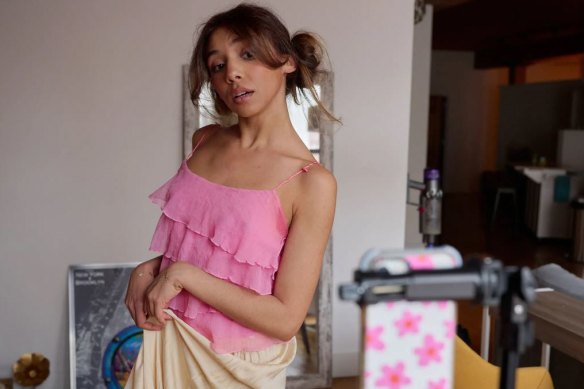
Potenza has more than 3.8 million followers on TikTok — a following large enough that it can translate into lucrative brand deals, bonuses and merchandise sales. Her videos, she said, have earned her more than $US200,000 ($302,000) annually.
Making a CringeTok video
Popular creators on TikTok can make a living in all kinds of niches on the platform, including by doing makeup, dealing watches, being old — even drinking flavoured water. But CringeTok is more like putting on a show.

Riri Bichri started posting CringeTok videos in 2020, and by April, she had quit her job as an electrical engineer to pursue content creation full time.Credit: Lexi Parra for The New York Times
To craft the perfect CringeTok video, creators mine the depths of the internet and their own experiences for traits they can exaggerate. Identifying behaviours that make us recoil, such as self-absorption and obliviousness, requires an ironic amount of self-reflection. Cringe comedy creators often build time for dreaming up sketches into their schedules. Filming can take as little as an hour — often from the comfort of the creators’ bedrooms.
These videos are different from unintentionally cringey videos in which an overabundance of earnestness combined with a lack of self-awareness leaves viewers feeling uncomfortable.
In those cases, “we’re not laughing with you,” Potenza said. “We’re laughing at you.”
Riri Bichri started posting CringeTok videos in 2020, and by April, she had quit her job as an electrical engineer to pursue content creation full time. She has built a following of 800,000 subscribers by drawing on 2000s rom-com tropes, fan fiction and her own cringey behavior for inspiration.
“If I’m not embarrassed by what I did yesterday, if I’m not cringing about what I did yesterday, I did not grow,” Bichri said.
Brad Podray, 40, is an orthodontist in Des Moines, Iowa, whose TikTok account, the Scumbag Dad, was originally a riff on the work of another TikTok creator, Nick Cho. Known online as Your Korean Dad, Cho plays a wholesome, fatherly figure who treats viewers as if they were his beloved children.
“A lot of my main comedy is based on identifying trends and deconstructing them to the point where they are no longer recognisable from the original inspiration,” Podray said.
Loading
His POV-style videos feature a series of short sketches in which the Scumbag Dad exposes his fictional kid to progressively volatile situations. Early in Season One of the parodies, Podray steals his child’s prescription pain medication, and by Season Six, his child is helping him assassinate drug dealers.
“I never got to complete the series, unfortunately, because TikTok banned me too many times,” Podray said. TikTok prohibits videos featuring youth exploitation and abuse, fictional or otherwise, in its community guidelines, but Podray continues to make other kinds of parody videos. He said he earned about $US150,000 a year from his content on TikTok and YouTube.
How it all works
In July 2020, TikTok established the Creator Fund to reward popular accounts and encourage content creation. It initially pledged to distribute $US200 million and now expects the fund to grow beyond $US1 billion. How much each creator gets, however, can vary.
“Payouts from the Creator Fund are based on a number of factors,” said Maria Jung, TikTok’s global product communications manager. “These factors include what region your video is viewed in, engagement on your video and the extent to which your video adheres to our community guidelines and terms of service.”

Wendell Scott, 32, is a production coordinator in Atlanta who instructs Delta Air Lines on how to make effective social media content. He uses his downtime to create TikTok videos, some of which have millions of views.Credit: Wulf Bradley for The New York Times
It has been widely reported that eligible creators typically get a few cents for every thousand views a video gets, although Jung wouldn’t confirm that number.
Creators with millions of followers and views per video can make a few thousand dollars a month from the Creator Fund. Having an engaged TikTok audience also allows creators to extend their reach on other social platforms. Meta discontinued their Reels Play bonus program in March, but creators can still earn money from Facebook Ad Reels, a program that operates similarly to YouTube’s revenue-sharing model.
Cross-posting content to increase revenue streams is a common practice among creators.
“It wasn’t until I became monetised on YouTube that I actually started making real money,” Potenza said. “In order to make this a living, you have to utilise a lot of different methods to make it sustainable.”
YouTube’s business model is different from TikTok’s in that it shares 50 per cent of its ad revenue with its creators.
The combined revenue from social platforms can be significant, but the most lucrative opportunities come from brand partnerships.
Loading
Potenza recently created a sketch in which she played John Wick’s therapist to promote the latest movie in the John Wick franchise. Podray’s sponsors include Insta360, a camera company, and Lovehoney, an online sex toy store.
As their follower counts and average views per video grow, so do their rates. Potenza secured her first brand deal in 2020 and filmed a branded video for $US150. The next year, as her account grew and she hired an agent to help her negotiate, her rate increased to $US5,000 per video. These days, she wouldn’t accept anything less than $US10,000 for a sponsored post.
Bichri has gotten brand deals with companies such as CashApp, Bubble Skincare and Pluto TV, but she’s unsure how much money she has earned because, she said, her agency hasn’t paid her for work she has done.
A nationwide TikTok ban, proposed in Congress because of the app’s Chinese ownership, would put all creator revenue streams — not to mention hard work — into question.
“Watching a bunch of congresspeople talking at the CEO of TikTok about things they don’t understand was really embarrassing,” Potenza said. “It makes me super pro-China at this point.”
Everything’s cringe
What isn’t cringe today can be cringe tomorrow. Much like death and taxes, cringe comes for everyone eventually. So, it shouldn’t come as a surprise that brands are interested in participating. Being authentically embarrassing is still authentic.
Wendell Scott, 32, is a production coordinator in Atlanta who instructs Delta Air Lines on how to make effective social media content. He uses his downtime to create TikTok videos in which he provides one side of a cringey conversation in a duet or stitched video with other creators. In one video with nearly 2 million views, he plays a Founding Father who discovers John Hancock’s large signature on the Declaration of Independence.
“For me, cringe is something that we’ve all experienced, but we don’t like to talk about it,” Scott said. “Every single person has had some sort of odd, off-the-wall moment or something they think is off the wall, but it’s actually very real. And I love bringing that to life.”
This article originally appeared in The New York Times.
Get news and reviews on technology, gadgets and gaming in our Technology newsletter every Friday. Sign up here.



























